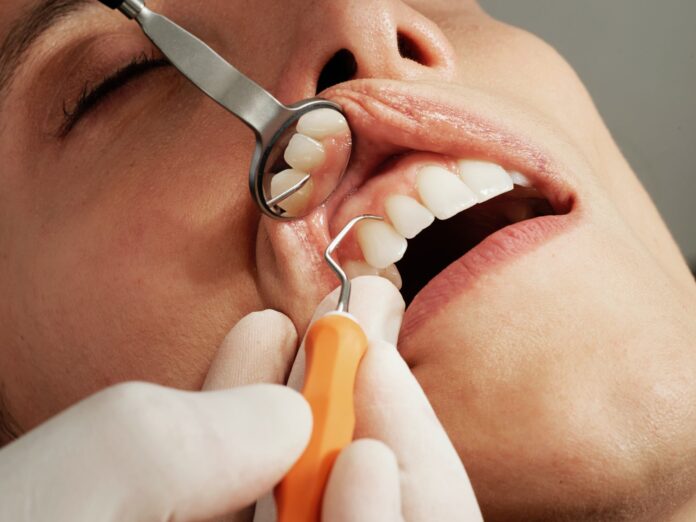Ceramic veneers are thin shells made of high-quality porcelain or ceramic material designed to cover the front surface of teeth. Their seamless and natural appearance is guaranteed by their custom-made design, which mimics the size, shape, and colour of your own teeth. These veneers are mostly used to enhance the look of teeth that are missing, damaged, misaligned, or discoloured.
What sets ceramic veneers apart from other cosmetic dental treatments is their durability and resistance to staining. They offer a long-lasting solution that can withstand the rigors of daily wear and tear while maintaining their pristine appearance. This makes them an ideal choice for individuals looking to enhance their smile with minimal maintenance.
The Process of Getting Ceramic Veneers
Getting ceramic veneers typically involves several key steps, each meticulously planned and executed to ensure the best possible outcome. Here’s a detailed look at the process:
- Consultation and Assessment: The initial step involves a thorough consultation with a cosmetic dentist. During this visit, the dentist will assess your dental health, discuss your aesthetic goals, and determine whether ceramic veneers are the right option for you. They will also take impressions of your teeth to create custom veneers that fit perfectly.
- Preparation: Once you’ve decided to proceed with veneers, the dentist will prepare your teeth by removing a small amount of enamel from the front surface. This is necessary to ensure that the veneers sit flush with your natural teeth and do not appear bulky. The amount of enamel removed is minimal, typically no more than half a millimeter.
- Impressions and Temporary Veneers: After the teeth are prepared, impressions are taken and sent to a dental laboratory where your custom veneers will be crafted. In the meantime, the dentist will place temporary veneers to protect your teeth and provide a preview of your new smile.
- Fitting and Bonding: Once the custom veneers are ready, you will return to the dentist for fitting. The dentist will ensure that each veneer fits perfectly and matches the color of your natural teeth. They will then clean your teeth thoroughly and use a special adhesive to bond the veneers to your teeth. A curing light is used to harden the adhesive, securing the veneers in place.
- Final Adjustments and Follow-Up: The final step involves making any necessary adjustments to the veneers to ensure a comfortable fit and a natural appearance. The dentist will schedule a follow-up visit to check on your new veneers and address any concerns you may have.
Benefits of Ceramic Veneers
Ceramic veneers offer numerous advantages that make them a preferred choice for many individuals seeking to improve their smiles. Here are some of the key benefits:
Natural Appearance: The translucency and color-matching capabilities of ceramic veneers make them virtually indistinguishable from natural teeth. This ensures that your new smile looks natural and aesthetically pleasing.
Durability: Ceramic veneers are known for their strength and durability. With proper care, they can last for many years, providing a long-term solution for various dental imperfections.
Stain Resistance: Unlike natural teeth, ceramic veneers are resistant to staining from coffee, tea, wine, and other common substances. This helps maintain the brightness and beauty of your smile over time.
Minimal Invasiveness: The process of applying ceramic veneers is less invasive than other cosmetic dental procedures. It involves minimal removal of enamel and does not require extensive reshaping of the tooth.
Improved Confidence: A beautiful smile can significantly boost your self-confidence and enhance your overall appearance. With ceramic veneers, you may have the smile of your dreams and feel more self-assured in social and work situations.
Potential Drawbacks and Considerations
While ceramic veneers offer many benefits, it is important to be aware of potential drawbacks and considerations before deciding to undergo the procedure:
Cost: Ceramic veneers can be more expensive than other cosmetic dental treatments. However, many people find that the investment is worth it for the long-term benefits and improved aesthetics.
Irreversibility: The process of applying veneers involves the permanent removal of a small amount of enamel. This means that once you have veneers, you will always need some form of dental covering on the treated teeth.
Sensitivity: Some patients may experience temporary sensitivity to hot or cold temperatures following the placement of veneers. This sensitivity usually subsides within a few days or weeks.
Maintenance: While veneers are durable, they still require regular dental care to maintain their appearance and function. This includes brushing and flossing daily, as well as regular visits to the dentist for check-ups and cleanings.
Ceramic Veneers vs. Other Cosmetic Dental Options
When considering ceramic veneers, it’s important to understand how they compare to other cosmetic dental options. Here’s a brief comparison with some common alternatives:
Teeth Whitening: Teeth whitening is a non-invasive procedure that can effectively remove stains and brighten your smile. However, it does not address issues such as chipped or misaligned teeth, which ceramic veneers can correct.
Composite Bonding: Composite bonding involves applying a tooth-colored resin to repair chips or gaps in teeth. While it is less expensive than veneers, it is not as durable and may require more frequent touch-ups.
Orthodontics: Braces or clear aligners can straighten misaligned teeth, but they do not address discoloration or shape issues. Veneers can provide a quicker solution for those seeking immediate aesthetic improvements.
Crowns: Dental crowns cover the entire tooth and are typically used for more extensive repairs. They are more invasive than veneers and require more removal of tooth structure.
The Long-Term Care of Ceramic Veneers
Proper care is essential to ensure the longevity and effectiveness of your ceramic veneers. Here are some tips for maintaining your new smile:
Maintain Good Oral Hygiene: Brush your teeth at least twice a day and floss daily to prevent plaque buildup and maintain healthy gums.
Avoid Hard Foods: While ceramic veneers are durable, it’s best to avoid biting into hard foods or objects, such as ice or pens, which can damage the veneers.
Wear a Mouthguard: If you grind your teeth at night or engage in contact sports, consider wearing a mouthguard to protect your veneers from damage.
Regular Dental Visits: Schedule regular check-ups with your dentist to monitor the condition of your veneers and address any potential issues early.
Conclusion: A Brighter Future with Ceramic Veneers
Ceramic veneers offer a remarkable solution for anyone looking to enhance their smile and boost their confidence. With their natural appearance, durability, and stain resistance, they are an excellent choice for achieving a radiant smile. By understanding the process, benefits, and considerations involved, you can make an informed decision about whether ceramic veneers are right for you. With the guidance of a skilled cosmetic dentist, you can embark on a journey towards a brighter, more beautiful smile that you can be proud of for years to come.


























